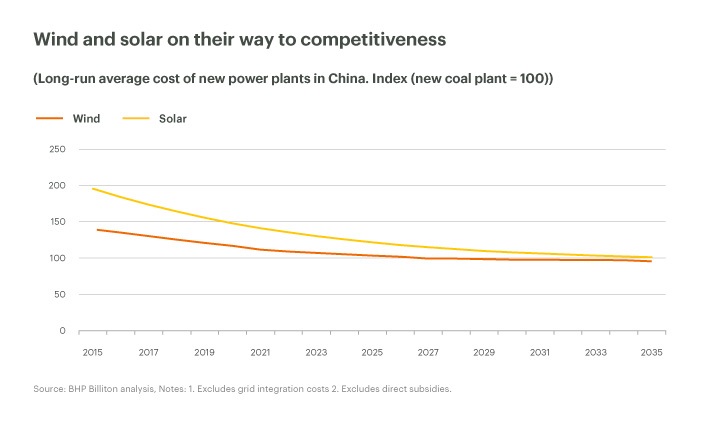
While met coal is clearly the star performer of the 2016 rally in mining and metals, thermal coal is probably the biggest surprise – seaborne prices are up 65% in 2016 to above $80 a tonne.
Even at today’s higher prices coal-fired power stations still represent one of the cheapest options to add power generation capacity. But according to a new blog post from top miner BHP Billiton, renewable energy sources are quickly closing the competitive gap:
On average, wind and solar energy are expected to reach cost-parity with incumbent technologies on a new-build, unsubsidised basis in about a decade. As an example, the chart below depicts the expected cost of building new wind and solar plants relative to new coal in China – the world’s largest power market.
BHP adds that in some markets with excellent solar or wind resources, such as Chile and Morocco, the tipping point has already been passed.

Source: BHP Billiton
4 Comments
klgmac
Gosh, I have ben hearing that claim for at least two decades. Apparently increased demand for raw materials like lithium won’t cause prices to increase. Meanwhile expensive electricity generated by alternative sources are forcing people into energy poverty and are a crime against humanity.
“Some relevant excerpts of the article noting that the German energy policy is being carried out on the backs of those who can least afford it, the poor, the old, the dispossessed. ”
http://www.democraticunderground.com/112759355
J. D. Baker
Read the fine print and exclusions. When a truly competitive “all in” net cost is reached which properly reflects all factors and concerns used by conventional energy generation, we will see a genuine transition to renewables, free of government subsidies, regulatory mandates and pressure, etc.
During interim, when technically literate people consider cost parity of renewables vs conventional, we do not simply ignore baseload continuous availability, involuntary (uncontrolled) power output variability, grid integration costs and subsidies (both direct and indirect), regulatory impacts that shift costs and distort metrics, etc.
prince george
where are the mass produced hydrogen fuel cell cars promised in the year 2003 , they were supposed to be all over the place within a decade just like this fantasy article … do some research on the filthy process of producing polysilicon
Salgood Sam
Like most if not all fossil fuels, if federal coal subsidies were pulled, i bet it would already be cheaper.